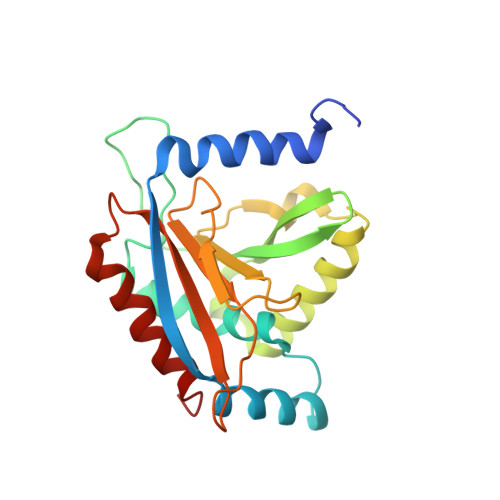Why are the 2-oxoacid dehydrogenase complexes so large? Generation of an active trimeric complex.
Marrott, N.L., Marshall, J.J., Svergun, D.I., Crennell, S.J., Hough, D.W., van den Elsen, J.M., Danson, M.J.(2014) Biochem J 463: 405-412
- PubMed: 25088564
- DOI: https://doi.org/10.1042/BJ20140359
- Primary Citation of Related Structures:
4OFS - PubMed Abstract:
The four-component polypeptides of the 2-oxoacid dehydrogenase complex from the thermophilic archaeon Thermoplasma acidophilum assemble to give an active multienzyme complex possessing activity with the branched-chain 2-oxoacids derived from leucine, isoleucine and valine, and with pyruvate. The dihydrolipoyl acyl-transferase (E2) core of the complex is composed of identical trimer-forming units that assemble into a novel 42-mer structure comprising octahedral and icosahedral geometric aspects. From our previously determined structure of this catalytic core, the inter-trimer interactions involve a tyrosine residue near the C-terminus secured in a hydrophobic pocket of an adjacent trimer like a ball-and-socket joint. In the present study, we have deleted the five C-terminal amino acids of the E2 polypeptide (IIYEI) and shown by equilibrium centrifugation that it now only assembles into a trimeric enzyme. This was confirmed by SAXS analysis, although this technique showed the presence of approximately 20% hexamers. The crystal structure of the trimeric truncated E2 core has been determined and shown to be virtually identical with the ones observed in the 42-mer, demonstrating that removal of the C-terminal anchor does not significantly affect the individual monomer or trimer structures. The truncated E2 is still able to bind both 2-oxoacid decarboxylase (E1) and dihydrolipoamide dehydrogenase (E3) components to give an active complex with catalytic activity similar to the native multienzyme complex. This is the first report of an active mini-complex for this enzyme, and raises the question of why all 2-oxoacid dehydrogenase complexes assemble into such large structures.
Organizational Affiliation:
*Centre for Extremophile Research, Department of Biology and Biochemistry, University of Bath, Bath BA2 7AY, U.K.














